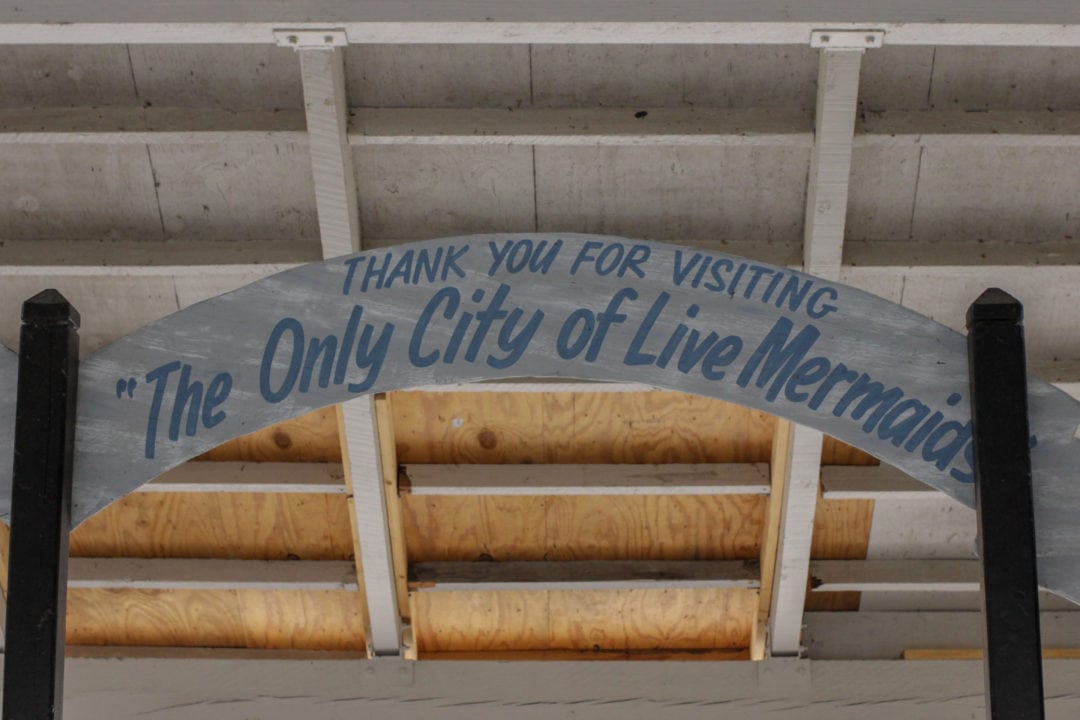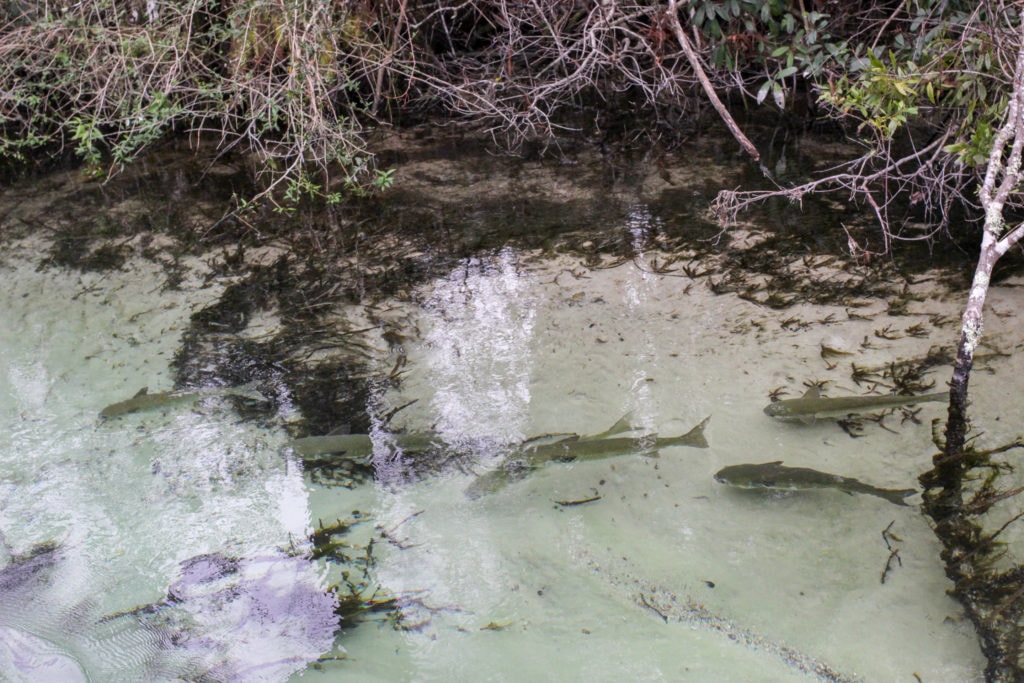Driving through Western Florida, I am struck by how different it feels from its geographic neighbors—the pure white beaches of the east, the tropical flavor of the south, the family-friendly entertainment in the center. The western part of the state is more like a fairytale awash in brilliant greens and blues. While the state has changed dramatically in many ways throughout its history, the roots of its robust tourism ecosystem are still very much on display in this area. The main event here is not Mickey or Miami, but rather a mermaid attraction with a legacy that mirrors that of the road trip itself.
Like so much of roadside culture, the aquatic performers’ story begins at the end of World War II. Newton Perry, a U.S. Navy officer, came to the then-rural town of Weeki Wachee to open a new attraction. One of his military duties had been training sailors to hold their breath underwater for long periods of time, and after purchasing land near the town’s natural springs, he had the idea of turning that trick into a show.




Perry created a hose that ran air from the surface of the springs and tucked discreetly into various set decorations. With this innovation, performers could stay underwater seemingly uninhibited, only occasionally ducking away to refill on air. Eventually, other tricks would be added to their repertoire, perhaps most famously drinking a Coke underwater. Performers would take a deep breath, sip some soda, and keep performing. By this time, they had moved on from simple swimsuits to fins and tails, and the “mermaid capital of the South” was born.
On October 13, 1947, the first mermaid show premiered in the underwater theater at Weeki Wachee Springs. It came at just the right time; by the 1950s, GIs and their Baby Boomer progeny were taking off across the newly created highways in search of beautiful scenery and unique attractions. While many of its contemporaries faded into obscurity, Weeki Wachee Springs persisted over the years, perhaps due to a blend of local engagement and proximity to the next tourist boom.
Just as the homegrown, almost joyfully schlocky attractions were fading out, massive theme parks—led by Walt Disney World’s opening in 1971—were coming in, attracting more and more visitors to the Sunshine State. Through it all, Weeki Wachee—less than two hours west of Orlando and not too close or too far from competing attractions—has carried on undeterred.

Mermaids and manatees
Mermaids and Florida have a long, intertwined history. Sailors traveling near the state frequently claimed to have seen the watery sirens in the distance. As it turned out, they were most likely spotting a slightly different creature: those round, chronically peaceful animals we now know as manatees, or “sea cows.” The mammals (no longer endangered but officially classified as “vulnerable”) still make their home in these waters just across the way from the Weeki Wachee underwater theater.
I arrive at Weeki Wachee in between shows, so I spend some time roaming the grounds. The first stop is a boat tour that takes several retirees and myself on a journey into the pseudo-wilderness. We watch for sea cows amid the river grasses and impossibly clear blue water. Even though I don’t see much wildlife, the beautiful ride offers a great deal of insight into the ecological factors that made this attraction possible in the first place.
The natural springs flow from the Weeki Wachee River, which winds all the way to the Gulf of Mexico. A 2017 survey revealed that the river houses the deepest known freshwater cave system in the U.S. To this day, the bottom hasn’t been found.

It’s showtime
Once the boat docks, I stop by the outdoor stage where a ranger is showing off fascinating local reptiles, including alligators. When it’s finally time for the big show, I enter the musty, 400-seat auditorium embedded in the side of the spring 16 feet below the water’s surface.
Much like the entertainment landscape around them, the Weeki Wachee mermaids have evolved over the decades. Today, they are less about a collection of stunts and more about incorporating said tricks into a theme; in this case, a retelling of The Little Mermaid that gracefully skirts copyright laws. But some of the old traditions remain.
Before the official show starts, the performers show off some of their skills, including the soda-sipping trick. Sitting in the well-worn seats, gazing at a massive pane of cloudy glass while state legend Jimmy Buffet performs a Weeki Wachee-specific version of his song “Fins” on a boxy TV overhead, I can almost feel the ghostly imprints of thousands of visitors past. Celebrities and ordinary families—their hands on the peeling tiles, their faces pressed against the glass—have all come to Weeki Wachee over the years, for an afternoon of Old Florida kitsch.


Once a mermaid, always a mermaid
To be a Weeki Wachee mermaid is still a tremendous honor. Like fellow Southern icon Dolly Parton, the mermaids have transcended their glamorous imagery to become pillars of their community. A program called “Tail Mail” allows local students under the age of 17 to write a letter to the mermaid of their choice. There’s also a “Mermaid Roster,” where you can learn about the performers’ favorite foods and music, their pets and their guilty pleasures, and their post-mermaid dreams of becoming scuba instructors or Supreme Court Judges.
Mermaid Cheyenne loves shrimp cocktails and wants to be a pediatric oncology nurse one day. Her favorite book is Dr. Seuss’ Green Eggs and Ham. Her celebrity crush is Dave Franco. Like many of the mermaids, she is a Weeki Wachee local and has a deep love for the park. “I grew up in the area, idolizing these women and knew this is what I wanted to do when I became old enough,” she says. “Living in the area, everyone is familiar with the Weeki Wachee Mermaids. Knowing that I’m a part of seven decades of this iconic park is awesome.”


It has never been simple to become a mermaid. In the beginning, even before the addition of fins, the performers took classes in etiquette and ballet. “The training process is intense,” Cheyenne says. “It takes, on average, four to six months of training before you even perform in a show.” The mermaids form a sorority, with alumni returning on occasion for special appearances, uniting under the credo, “Once a mermaid, always a mermaid.”
Deep, timeless waters
Weeki Wachee is one of those rare places that manages to seamlessly straddle many eras. Its gimmicks harken back to the golden age of traveling, and offer a living historical context to the fantastical entertainment boom that was to follow. And tying it together is a natural beauty so dazzling that people couldn’t help but capitalize on it.




My last stop after the show is the park’s swimming area, with its twin slides twisting overhead. The pool is part of the springs, with only a rope separating it from the area where the mermaids enter for their performance. Jumping into the blue, surrounded by others doing the same, it’s easy to understand the area’s timeless appeal.
I swim alongside schools of fish whose movements mirror my own. When I hoist myself up onto the diving platform, the fish carry on beneath me, passing through waters wonderfully long and unfathomably deep.
If you go
Weeki Wachee mermaids perform daily, 365 days a year at 11 a.m., 1:30 p.m., and 3 p.m. The River Boat ride runs daily from 10 a.m. to 2 p.m. and the waterpark is open seasonally.








